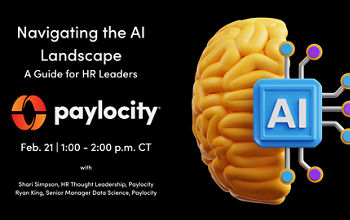Our platform facilitates succession planning, ensuring seamless transitions and development paths for your talent pool. With advanced recruiting features and customizable benefits offerings, you'll attract and retain top talent effortlessly. Additionally, our AI-driven automation saves valuable time by streamlining tasks like payroll processing, allowing your team to focus on strategic initiatives and scale your organization efficiently.
HR and Payroll Software for Tech Companies
Tech-Forward Solutions for Tech-Savvy Employees
Experience our cutting-edge HR and payroll solution that combines end-to-end capabilities for HR with AI-powered tools for higher efficiency and engagement. Plus, integrations with other business systems to centralize your data in once place.
- Foster an engaged culture with a user-centric interface and advanced collaboration tools.
- Harness automation to ensure error-free payroll processing, streamline benefits administration, and optimize employee management tasks.
- Attract and retain top tech talent with integrated AI-powered recruiting and onboarding tools.

Jump-Start Your Growth with Modern Solutions
- Recruiting
-
Attract and Retain Tech Talent
Find candidates with the precise, specialized skills you need.
- Leverage market-leading compensation benchmarking to set competitive salaries.
- Administer comprehensive and customizable benefits packages to support your workforce for long-term success.
- Ensure inclusive hiring practices through innovative tools that monitor workforce diversity, mitigating bias and fostering a culture of equality.
- Integrations
-
Connect to Business-Critical Systems
Seamlessly connect our end-to-end HR platform with other solutions to meet the needs of your business.
- Extend the platform with hundreds of integrations available in the Paylocity Marketplace.
- Enhance security and convenience with Single Sign-On (SSO).
- Build a custom integration with open APIs, developer-friendly documentation, and integration service providers in the Marketplace.
- Payroll
-
Reclaim Your Time with Tech-Centric Payroll Solutions
Maximize your focus on strategic initiatives by simplifying payroll processes. Benefit from advanced features tailored for tech companies:
- Automate data flow from Time & Labor to Payroll, eliminating manual entry and ensuring seamless payroll processing.
- Rely on our expert payroll tax services for timely and reliable support, including global payroll capabilities for managing diverse teams effortlessly.
- Streamline expense management with automated data flow from Expense to Payroll, reducing the need for separate tools or processes and enhancing efficiency.
- Compliance
-
Manage Compliance from One Location
Navigate the complexities of HR compliance and keep your business running smoothly.
- View all employee compliance items from one user-friendly dashboard.
- Access interactive compliance courses on sexual harassment, anti-violence, and cyber security, complete with easy assignment and tracking.
- Get peace of mind with access to HR services that help you minimize compliance risk and implement industry best practices.
Attract and Retain Tech Talent
Find candidates with the precise, specialized skills you need.
- Leverage market-leading compensation benchmarking to set competitive salaries.
- Administer comprehensive and customizable benefits packages to support your workforce for long-term success.
- Ensure inclusive hiring practices through innovative tools that monitor workforce diversity, mitigating bias and fostering a culture of equality.

Connect to Business-Critical Systems
Seamlessly connect our end-to-end HR platform with other solutions to meet the needs of your business.
- Extend the platform with hundreds of integrations available in the Paylocity Marketplace.
- Enhance security and convenience with Single Sign-On (SSO).
- Build a custom integration with open APIs, developer-friendly documentation, and integration service providers in the Marketplace.

Reclaim Your Time with Tech-Centric Payroll Solutions
Maximize your focus on strategic initiatives by simplifying payroll processes. Benefit from advanced features tailored for tech companies:
- Automate data flow from Time & Labor to Payroll, eliminating manual entry and ensuring seamless payroll processing.
- Rely on our expert payroll tax services for timely and reliable support, including global payroll capabilities for managing diverse teams effortlessly.
- Streamline expense management with automated data flow from Expense to Payroll, reducing the need for separate tools or processes and enhancing efficiency.

Manage Compliance from One Location
Navigate the complexities of HR compliance and keep your business running smoothly.
- View all employee compliance items from one user-friendly dashboard.
- Access interactive compliance courses on sexual harassment, anti-violence, and cyber security, complete with easy assignment and tracking.
- Get peace of mind with access to HR services that help you minimize compliance risk and implement industry best practices.

The Paylocity Difference
Supporting Technology Companies Just Like You
related resources
FAQs on Payroll Software for Tech Companies
At Paylocity, we prioritize your data security with adherence to SOC 2 and ISO compliance standards. Our enterprise-class data centers ensure physical security and uninterrupted product suite uptime. Through our formal security program and regular testing, we're dedicated to safeguarding your information as our top priority. Learn more about our commitment to data security.
Yes! Paylocity clients can extend the platform with hundreds of integrations available in our Marketplace. Activate connections based on your needs and manage all your active integrations right within Paylocity. You can also build custom integrations with open APIs. And if you need developer resources to get started, you can browse vetted service partners in the Marketplace.
HR and IT collaborate to make sure everything from digital onboarding to cybersecurity is organized and effective for everyone. HR maintains a centralized employee record that IT can leverage to manage access to applications and devices. They work together to improve processes creating a better experience for employees. Their teamwork keeps things running smoothly and securely across the board.






